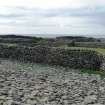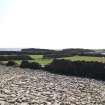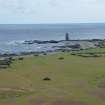Notice
Following a review of the Buildings at Risk Register we have paused the Register while we consider options for its future.
The website will remain accessible and searchable during this time, but it will not be updated and we’re not accepting nominations for additions to the Register. If you need to contact us about the BARR please email hmenquiries@hes.scot
Read the review report here and you can find out more about why we have paused the BARR on our news centre.
Sheep Dyke, Punds and Crues, Gravity
Ordnance Survey licence number AC0000807262. All rights reserved. © Copyright and database right 2025. Public Sector Viewing Terms
Useful Links
- Canmore:
- NORTH RONALDSAY, SHEEP DYKE AND ASSOCIATED PUNDS
- Historic Scotland:
- HS Reference No 46400
General Details and Location
Category
AT RISK
Name of Building
Sheep Dyke, Punds and Crues
Other Name(s)
Address
Gravity
Locality
Postcode
Planning Authority
Divisional Area
Reference No
3666
Listing Category
A
OS Grid Ref
HY 76499 54021
Location Type
Remote
HS Reference No
46400
Description
12-13 mile-long, roughly 6 foot high drystone island perimeter wall, incorporating numerous window-like openings; associated stone-built circular-plan 'punds' situated to N around Dennis Head.
The sheep dyke around North Ronaldsay is a unique and important structure, probably the largest drystone construction conceived of as a single entity in the world. Ownership of sheep was common with crofters being allocated numbers according to the size of the smallholding. The dyke was designed to keep the sheep, for the majority of the year, on the foreshore where they would 'graze' on seaweed. The nine circular 'punds', or pens, which can be found at the north end of the island served a particular purpose. 'Punding' was carried out six times a year as a communal exercise, in order to complete tasks related to the upkeep and organisation of the flock. (Historic Scotland)
The sheep dyke around North Ronaldsay is a unique and important structure, probably the largest drystone construction conceived of as a single entity in the world. Ownership of sheep was common with crofters being allocated numbers according to the size of the smallholding. The dyke was designed to keep the sheep, for the majority of the year, on the foreshore where they would 'graze' on seaweed. The nine circular 'punds', or pens, which can be found at the north end of the island served a particular purpose. 'Punding' was carried out six times a year as a communal exercise, in order to complete tasks related to the upkeep and organisation of the flock. (Historic Scotland)
Building Dates
1832 onwards
Architects
Unknown
Category of Risk and Development History
Condition
Poor
Category of Risk
Low
Exemptions to State of Risk
Field Visits
13/08/2009
Development History
September 2008: Information along with photographic evidence from Orkney Council suggests that the dykes are in poor condition, with some sections having collapsed.
May 2009: Local planners report that the sheep pund is to be recepient of grant aided repair (2009) work. Large sections of the walls are planned to be repaired over a period of three summers. The punds and sections of dyke around Dennis Head will be subject to a 30 years lease (from 2009) by the North Ronaldsay Community Trust.
August 2009: SCT visit the island and photograph the island and sections of the dykes, punds and crues.
May 2010: Local planners large sections of the punds were rebuilt last year, with a further section being allocated grant funding for repair this year. Set to Restoration in Progress.
27 March 2013: Local planners advise the structures were damaged during Winter storms. The Scottish Government is being approached to secure funding to repair the damaged caused.
9 September 2015: Local planners forward a condition assessment on the complex by Orkney Islands Council, carried out July 2015. Whilst repairs have been carried out, organised by the North Ronaldsay Sheep Court on behalf of the landowner, a series of severe Winter storms have caused additional damage to the structure. The condition survey estimates that 4.7km of the 19.2 km structure now requires to be rebuilt - the inland structures generally being in either good or fair conditon but the sections along the shore have particularly suffered. The pace of the current repairs has been outstripped by the ongoing storm-damage, as such, entry moved back from Restoration in Progress to At Risk.
The island's development trust, the North Ronaldsay Trust, seeks to support repairs to the sheep dyke. A new organisation, the Orkney Sheep Foundation, has recently been established with the object of securing the future of the native seaweed-eating sheep on the foreshore of North Ronaldsay.
The island's development trust, the North Ronaldsay Trust, seeks to support repairs to the sheep dyke. A new organisation, the Orkney Sheep Foundation, has recently been established with the object of securing the future of the native seaweed-eating sheep on the foreshore of North Ronaldsay.
23 January 2020: The Orkney Sheep Foundation advise that the structures remain in much the same condition as outlined previously in the Orkney Islands Council condition assessment 2015. There has been some deterioration but no further large-scale damage - owing to the fact there have been no big storms in recent years. A new Sheep Dyke Warden was appointed in 2019 to safeguard the dyke and carry out emergency repairs. The annual Sheep Festival has been running since 2016, inviting volunteers to carry out repairs to storm-damaged parts of the dyke. Coastal erosion poses a major threat to parts of the dyke. Remains At Risk.
Guides to Development
Conservation Area
Planning Authority Contact
PAC Telephone Number
01856 873535
Availability
Current Availability
Unknown
Appointed Agents
Price
Occupancy
Vacant
Occupancy Type
Tenant(s)
Present/Former Uses
Name of Owners
North Ronaldsay Community Trust (as of 2009)
Type of Ownership
Unknown
Information Services
Additional Contacts/Information Source
Bibliography
Online Resources
Classification
Farming
Original Entry Date
09-OCT-08
Date of Last Edit
20/07/2016






